Analytical Modelling of a Refractive Index Sensor Based on an Intrinsic Micro Fabry-Perot Interferometer
Abstract
:1. Introduction
2. Refractive Index Sensing Setup
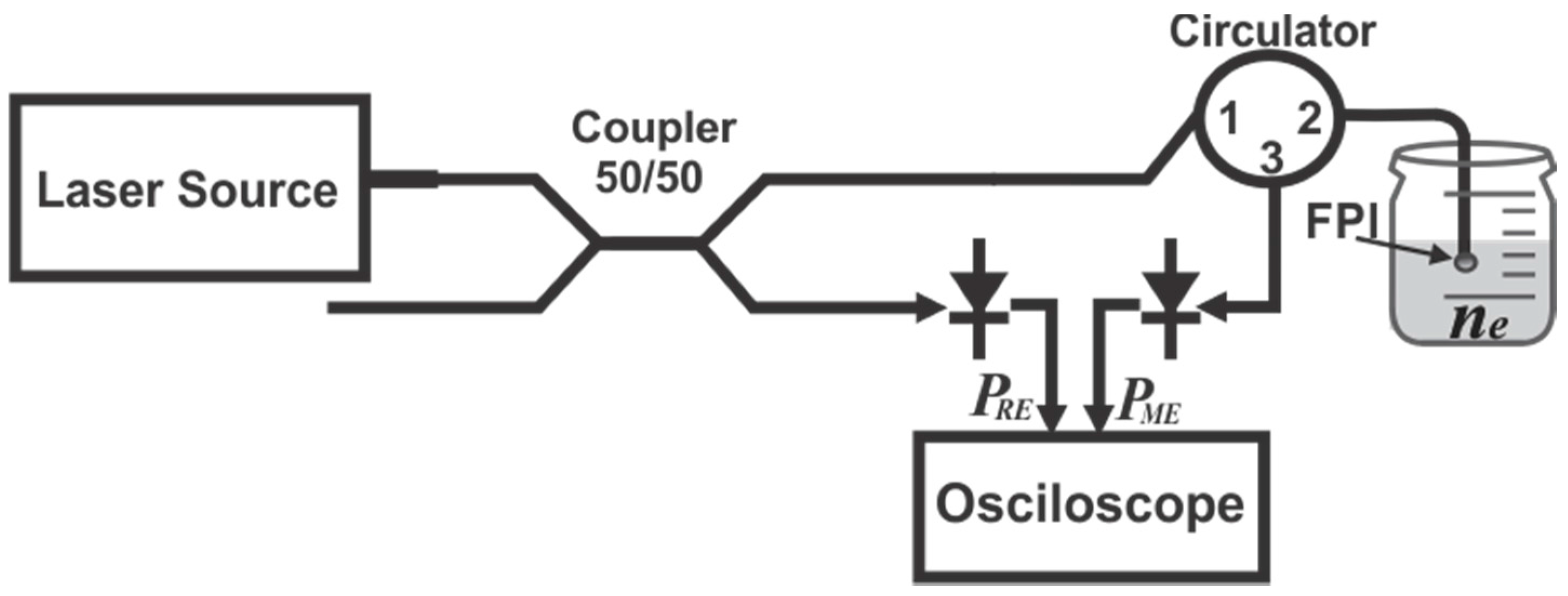
3. Characterization of the Micro FPI

FPI Principle of Operation
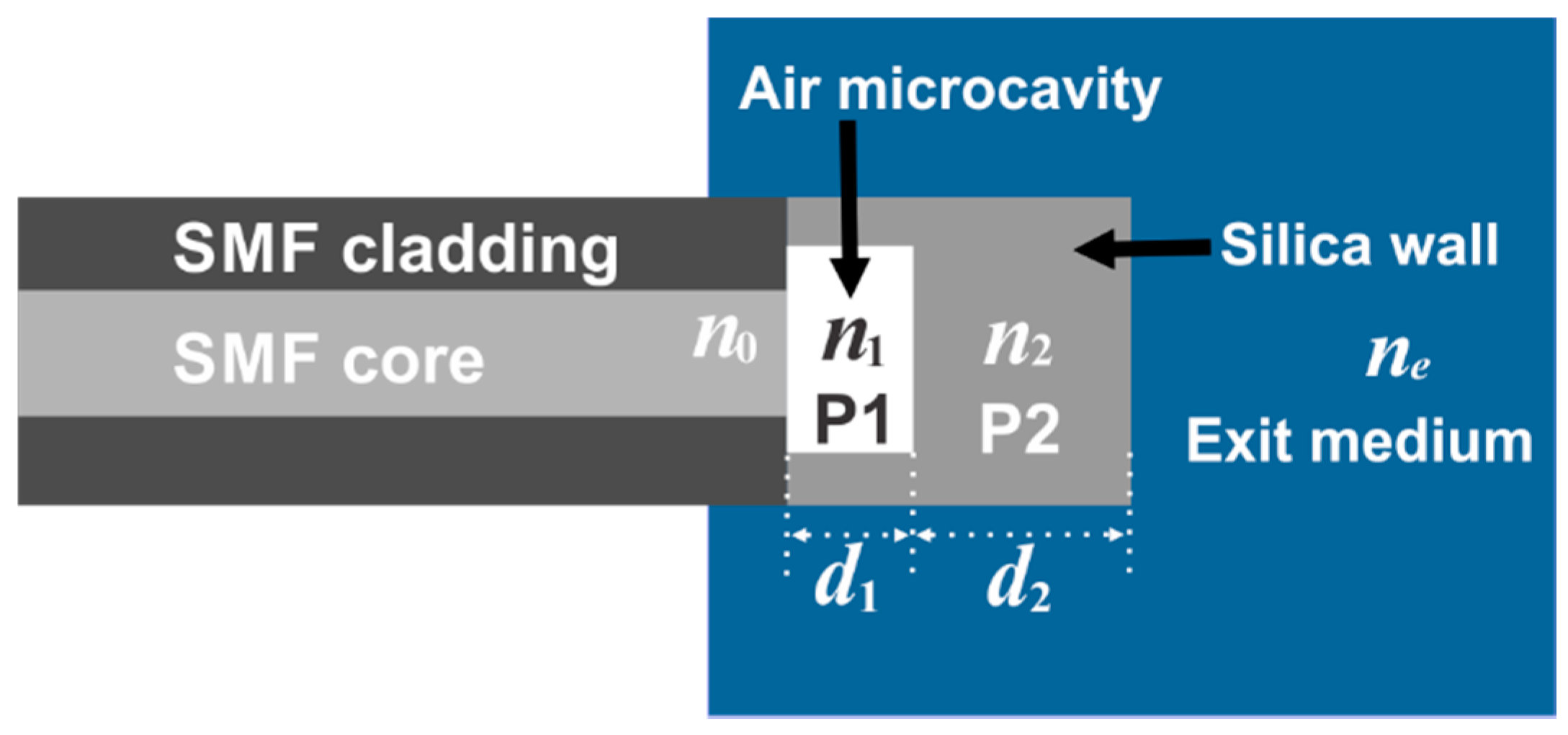
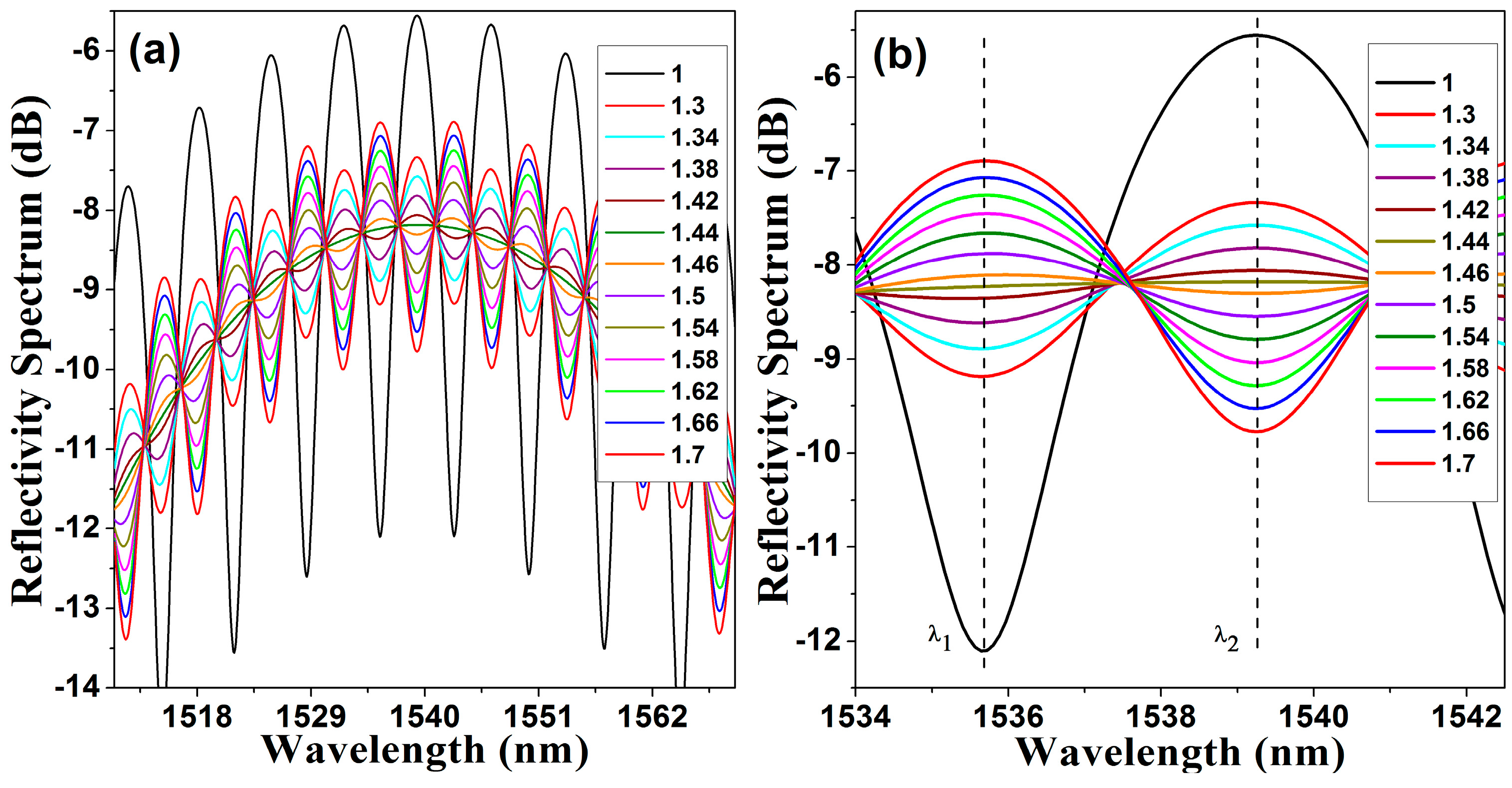
4. Experimental Results of the FPI Spectrum

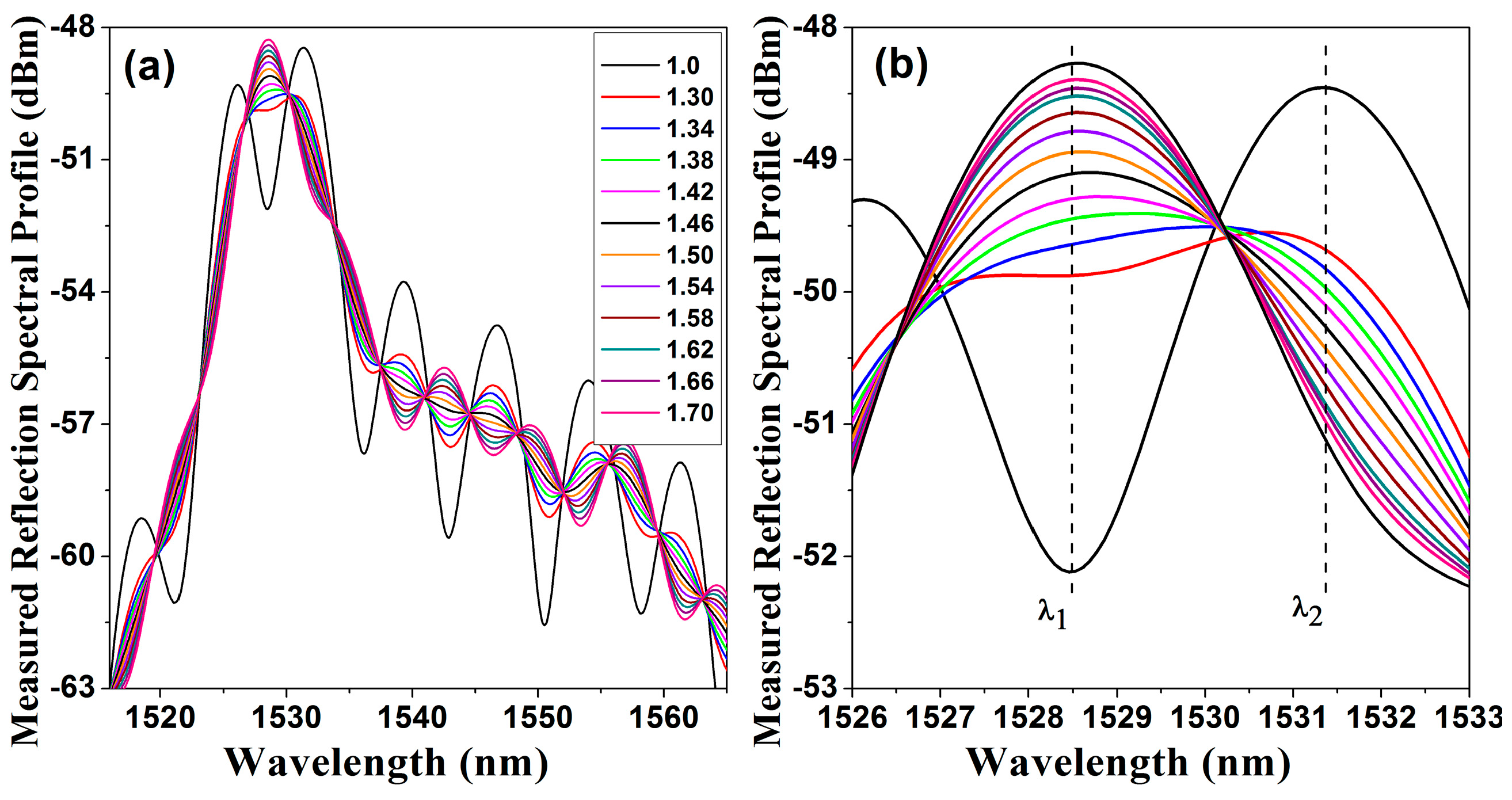
Characterization of the Amplitude of the FPI Fringes as a Function of the Exit Medium Refractive Index

5. Analysis of the Non Dispersive Refractive Index Sensor
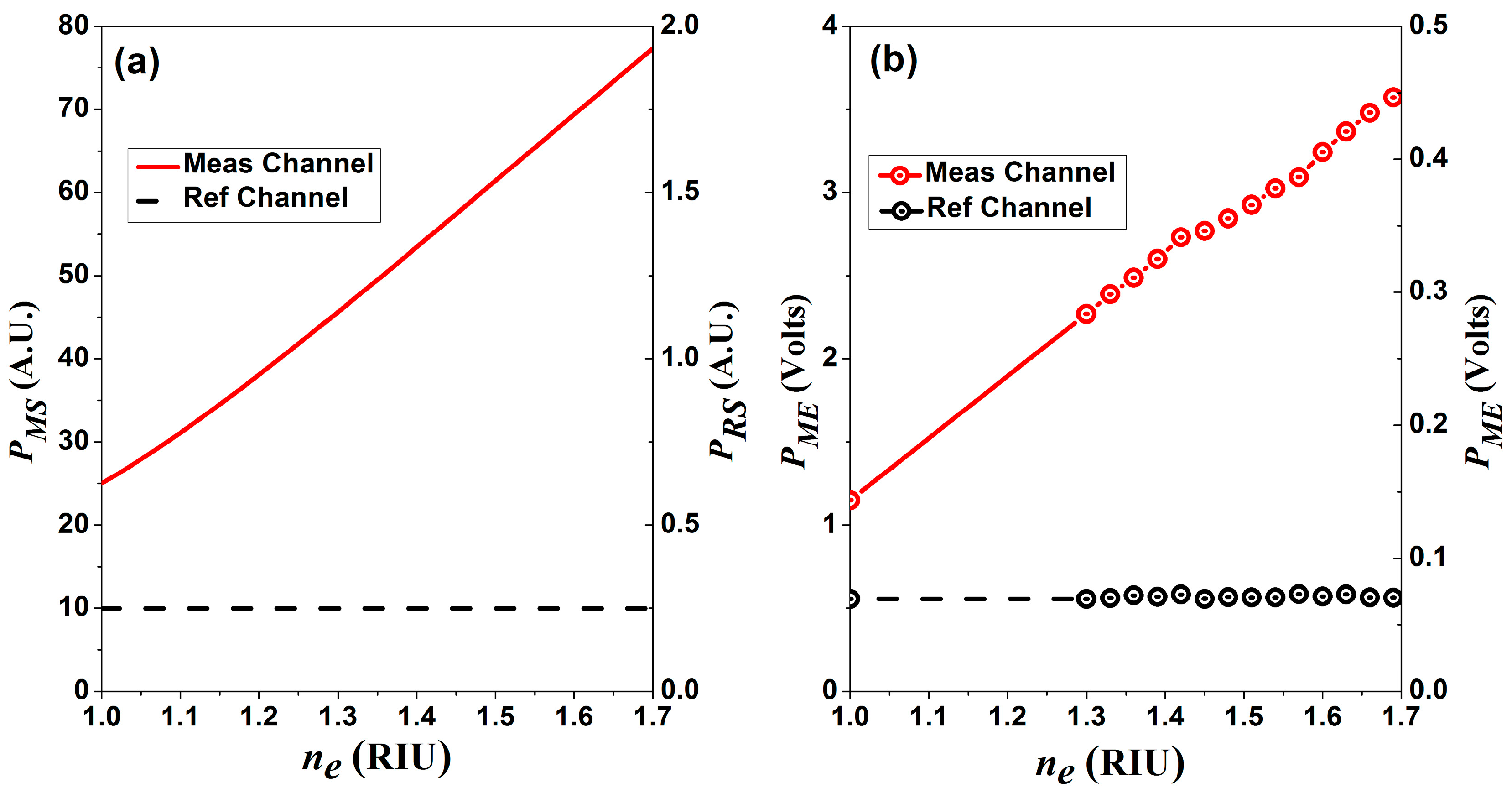
Depth of Modulation

6. Conclusions
Acknowledgments
Author Contributions
Conflicts of Interest
References
- Jorge, P.A.S.; Silva, S.O.; Gouveia, C.; Tafulo, P.; Coelho, L.; Caldas, P.; Viegas, D.; Rego, G.; Baptista, J.M.; Santos, J.L.; et al. Fiber optic-based refractive index sensing at inesc porto. Sensors 2012. [Google Scholar] [CrossRef] [PubMed]
- Kieu, K.Q.; Mansuripur, M. Biconical fiber taper sensors. IEEE Photonics Technol. Lett. 2006. [Google Scholar] [CrossRef]
- Liang, W.; Huang, Y.; Xu, Y.; Lee, R.K.; Yariv, A. Highly sensitive fiber bragg grating refractive index sensors. Appl. Phys. Lett. 2005. [Google Scholar] [CrossRef]
- Shao, M.; Qiao, X.; Jiasurname, Z.; Fusurname, H.; Liu, Y.; Li, H.; Zhao, X. Refractive index measurement based on fiber bragg grating connected with a multimode fiber core. Opt. Commun. 2015. [Google Scholar] [CrossRef]
- Meng, H.; Shen, W.; Zhang, G.; Tan, C.; Huang, X. Fiber bragg grating-based fiber sensor for simultaneous measurement of refractive index and temperature. Sens. Actuators B Chem. 2010. [Google Scholar] [CrossRef]
- Iadicicco, A.; Cusano, A.; Campopiano, S.; Cutolo, A.; Giordano, M. Thinned fiber bragg gratings as refractive index sensors. IEEE Sens. J. 2005. [Google Scholar] [CrossRef]
- Guan, C.; Tian, X.; Li, S.; Zhong, X.; Shi, J.; Yuan, L. Long period fiber grating and high sensitivity refractive index sensor based on hollow eccentric optical fiber. Sens. Actuators B Chem. 2013. [Google Scholar] [CrossRef]
- Kapoor, A.; Sharma, E.K. Long period grating refractive-index sensor: Optimal design for single wavelength interrogation. Appl. Opt. 2009. [Google Scholar] [CrossRef] [PubMed]
- Allsop, T.; Floreani, F.; Jedrzejewski, K.; Marques, P.; Romero, R.; Webb, D.; Bennion, I. Refractive index sensing with long-period grating fabricated in biconical tapered fibre. Electron. Lett. 2005. [Google Scholar] [CrossRef]
- Dianov, E.M.; Vasiliev, S.A.; Kurkov, A.S.; Medvedkov, O.I.; Protopopov, V.N. In-fiber mach-zehnder interferometer based on a pair of long-period gratings. In Proceedings of the 22nd European Conference on Optical Communication, ECOC’96, Oslo, Norway, 19 September 1996; Volume 1, pp. 65–68.
- Allsop, T.; Reeves, R.; Webb, D.J.; Bennion, I.; Neal, R. A high sensitivity refractometer based upon a long period grating mach–zehnder interferometer. Rev. Sci. Instrum. 2002. [Google Scholar] [CrossRef]
- Pieter, L.S. Long-period grating michelson refractometric sensor. Meas. Sci. Technol. 2004, 15, 1576–1580. [Google Scholar]
- Shi, L.; Xu, Y.; Tan, W.; Chen, X. Simulation of optical microfiber loop resonators for ambient refractive index sensing. Sensors 2007, 7, 689–696. [Google Scholar] [CrossRef]
- Lim, K.-S.; Aryanfar, I.; Chong, W.-Y.; Cheong, Y.-K.; Harun, S.W.; Ahmad, H. Integrated microfibre device for refractive index and temperature sensing. Sensors 2012, 12, 11782–11789. [Google Scholar] [CrossRef]
- Yang, H.J.; Wang, J.; Wang, S.S. Numerical calculation of temperature sensing in seawater based on microfibre resonator by intensity-variation scheme. J. Eur. Opt. Soc. Rapid Publ. 2014. [Google Scholar] [CrossRef]
- Sumetsky, M.; Dulashko, Y.; Fini, J.M.; Hale, A.; DiGiovanni, D.J. The microfiber loop resonator: Theory, experiment, and application. Lightwave Technol. J. 2006. [Google Scholar] [CrossRef]
- Kumar, A.; Subrahmanyam, T.V.B.; Sharma, A.D.; Thyagarajan, K.; Pal, B.P.; Goyal, I.C. Novel refractometer using a tapered optical fibre. Electron. Lett. 1984. [Google Scholar] [CrossRef]
- Monzón-Hernández, D.; Villatoro, J.; Luna-Moreno, D. Miniature optical fiber refractometer using cladded multimode tapered fiber tips. Sens. Actuators B Chem. 2005. [Google Scholar] [CrossRef]
- Kersey, A.D.; Jackson, D.A.; Corke, M. A simple fibre Fabry-Perot sensor. Opt. Commun. 1983. [Google Scholar] [CrossRef]
- Vikram, B.; Kent, A.M.; Richard, O.C.; Mark, E.J.; Jennifer, L.G.; Tuan, A.T.; Greene, J.A. Optical fibre based absolute extrinsic Fabry-Pérot interferometric sensing system. Meas. Sci. Technol. 1996, 7, 58–61. [Google Scholar]
- Rao, Y.-J.; Deng, M.; Duan, D.-W.; Yang, X.-C.; Zhu, T.; Cheng, G.-H. Micro Fabry-Perot interferometers in silica fibers machined by femtosecond laser. Opt. Express 2007. [Google Scholar] [CrossRef]
- Wei, T.; Han, Y.; Li, Y.; Tsai, H.-L.; Xiao, H. Temperature-insensitive miniaturized fiber inline Fabry-Perot interferometer for highly sensitive refractive index measurement. Opt. Express 2008. [Google Scholar] [CrossRef]
- Ran, Z.L.; Rao, Y.J.; Liu, W.J.; Liao, X.; Chiang, K.S. Laser-micromachined Fabry-Perot optical fiber tip sensor for high-resolution temperature-independent measurement of refractive index. Opt. Express 2008. [Google Scholar] [CrossRef]
- Liao, C.R.; Hu, T.Y.; Wang, D.N. Optical fiber Fabry-Perot interferometer cavity fabricated by femtosecond laser micromachining and fusion splicing for refractive index sensing. Opt. Express 2012. [Google Scholar] [CrossRef] [PubMed]
- Wang, T.; Wang, M. Fabry-Pérot fiber sensor for simultaneous measurement of refractive index and temperature based on an in-fiber ellipsoidal cavity. IEEE Photonics Technol. Lett. 2012. [Google Scholar] [CrossRef]
- Ma, J.; Ju, J.; Jin, L.; Jin, W.; Wang, D. Fiber-tip micro-cavity for temperature and transverse load sensing. Opt. Express 2011. [Google Scholar] [CrossRef] [PubMed]
- Duan, D.-W.; Rao, Y.-J.; Hou, Y.-S.; Zhu, T. Microbubble based fiber-optic Fabry-Perot interferometer formed by fusion splicing single-mode fibers for strain measurement. Appl. Opt. 2012. [Google Scholar] [CrossRef] [PubMed]
- Jauregui-Vazquez, D.; Estudillo-Ayala, J.M.; Rojas-Laguna, R.; Vargas-Rodriguez, E.; Sierra-Hernandez, J.M.; Hernandez-Garcia, J.C.; Mata-Chávez, R.I. An all fiber intrinsic Fabry-Perot interferometer based on an air-microcavity. Sensors 2013, 13, 6355–6364. [Google Scholar] [CrossRef] [PubMed]
- Jiang, X.; Chen, D. Low-cost fiber-tip Fabry-Perot interferometer and its application for transverse load sensing. Prog. Electromagn. Res. Lett. 2014, 48, 103–108. [Google Scholar] [CrossRef]
- Rao, Y.-J.; Deng, M.; Zhu, T.; Li, H. In-line Fabry-Perot etalons based on hollow-corephotonic bandgap fibers for high-temperature applications. Lightwave Technol. J. 2009, 27, 4360–4365. [Google Scholar]
- Rao, Y.-J. Recent progress in fiber-optic extrinsic Fabry-Perot interferometric sensors. Opt. Fiber Technol. 2006. [Google Scholar] [CrossRef]
- Choi, H.Y.; Park, K.S.; Park, S.J.; Paek, U.-C.; Lee, B.H.; Choi, E.S. Miniature fiber-optic high temperature sensor based on a hybrid structured Fabry-Perot interferometer. Opt. Lett. 2008. [Google Scholar] [CrossRef]
- Wang, J.; Dong, B.; Lally, E.; Gong, J.; Han, M.; Wang, A. Multiplexed high temperature sensing with sapphire fiber air gap-based extrinsic Fabry-Perot interferometers. Opt. Lett. 2010. [Google Scholar] [CrossRef] [PubMed]
- Li, Y.; Yan, G.; Zhang, L.; He, S. Microfluidic flowmeter based on micro “hot-wire” sandwiched Fabry-Perot interferometer. Opt. Express 2015. [Google Scholar] [CrossRef] [PubMed]
- Hou, W.L.; Liu, G.G.; Han, M. A novel, high-resolution, high-speed fiber-optic temperature sensor for oceanographic applications. In Proceedings of the 2015 IEEE/OES Eleventh Current, Waves and Turbulence Measurement (CWTM), St. Petersburg, FL, USA, 2–6 March 2015.
- Vargas-Rodriguez, E.; Rutt, H.N.; Rojas-Laguna, R.; Alvarado-Mendez, E. Calibration of a gas sensor based on cross-correlation spectroscopy. J. Opt. A Pure Appl. Opt. 2008, 10. [Google Scholar] [CrossRef]
- Carlson, H. Carbocap—New carbon dioxide sensor electrically tuneable interferometer for infrared gas analysis. Sens. Rev. 1997, 17, 304–306. [Google Scholar] [CrossRef]
- Dakin, J.P.; Gunning, M.J.; Chambers, P.; Xin, Z.J. Detection of gases by correlation spectroscopy. Sens. Actuators B Chem. 2003, 90, 124–131. [Google Scholar] [CrossRef]
- Zhang, G.; Lui, J.; Yuan, M. Novel carbon dioxide gas sensor based on infrared absorption. Opt. Eng. 2000, 39, 2235–2240. [Google Scholar] [CrossRef]
- Goody, R. Cross-correlating spectrometer. J. Opt. Soc. Am. B 1968, 58, 900–908. [Google Scholar] [CrossRef]
- Menzel, L.; Kosterev, A.A.; Curl, R.F.; Tittel, F.K.; Gmachl, C.; Capasso, F.; Sivco, D.L.; Baillargeon, J.N.; Hutchinson, A.L.; Cho, A.Y.; et al. Spectroscopic detection of biological no with a quantum cascade laser. Appl. Phys. B Lasers Opt. 2001, 72, 859–863. [Google Scholar] [CrossRef]
- Roller, C.; Namjou, K.; Jeffers, J.D.; Camp, M.; Mock, A.; McCann, P.J.; Grego, J. Nitric oxide breath testing by tunable-diode laser absorption spectroscopy: Application in monitoring respiratory inflammation. Appl. Opt. 2002, 41, 6018–6029. [Google Scholar] [CrossRef] [PubMed]
- Vaĭnshteĭn, L.A. Open resonators with spherical mirrors. Sov. Phys. J. Exp. Theor. Phys. 1964, 18, 471–479. [Google Scholar]
- Kerner, K.; Rochester, S.M.; Yashchuk, V.V.; Budker, D. Variable free spectral range spherical mirror fabry-perot interferometer. 2003. arXiv:physics/0306144. arXiv.org-Print archive. Available online: http://arxiv.org/abs/physics/0306144 (accessed on 18 June 2003).
- Ramsay, J.V. Aberrations of Fabry-Perot interferometers when used as filters. Appl. Opt. 1969, 8, 569–574. [Google Scholar] [CrossRef] [PubMed]
- Hernandez, G. Analytical description of a Fabry-Perot photoelectric spectrometer. Appl. Opt. 1966, 5, 1745–1748. [Google Scholar] [CrossRef] [PubMed]
- Born, M.; Wolf, E. Principles of Optics; Pergamon Press: Oxford, UK, 1970. [Google Scholar]
- Macleod, H.A. Thin-Films Optical Filters; Institute of Physics Publishing: Bristol, UK, 2001. [Google Scholar]
- Kuhn, H. New techniques in optical interferometry. Rep. Prog. Phys. 1951, 14, 64–94. [Google Scholar] [CrossRef]
- Vargas-Rodríguez, E.; Rutt, H.N. An analytical method to find the optimal parameters for gas detectors based on correlation spectroscopy using a Fabry-Perot interferometer. Appl. Opt. 2007, 46, 4625–4632. [Google Scholar] [CrossRef] [PubMed]
- Vargas-Rodríguez, E.; Rutt, H.; Claudio-Gonzalez, D.; Rojas Laguna, R.; Andrade-Lucio, J.A. Analytical approaches to optimization of gas detection using Fabry-Perot interferometer. In Chemical Sensors: Simulation and Modeling vol. 4: Optical Sensors; Momentum Press: New York, NY, USA, 2013. [Google Scholar]
- Dereniak, E.L.; Boreman, G.D. Infrared Detectors and Systems; John Wiley and Sons Inc.: Hoboken, NJ, USA, 1996. [Google Scholar]
© 2015 by the authors; licensee MDPI, Basel, Switzerland. This article is an open access article distributed under the terms and conditions of the Creative Commons Attribution license (http://creativecommons.org/licenses/by/4.0/).
Share and Cite
Vargas-Rodriguez, E.; Guzman-Chavez, A.D.; Cano-Contreras, M.; Gallegos-Arellano, E.; Jauregui-Vazquez, D.; Hernández-García, J.C.; Estudillo-Ayala, J.M.; Rojas-Laguna, R. Analytical Modelling of a Refractive Index Sensor Based on an Intrinsic Micro Fabry-Perot Interferometer. Sensors 2015, 15, 26128-26142. https://doi.org/10.3390/s151026128
Vargas-Rodriguez E, Guzman-Chavez AD, Cano-Contreras M, Gallegos-Arellano E, Jauregui-Vazquez D, Hernández-García JC, Estudillo-Ayala JM, Rojas-Laguna R. Analytical Modelling of a Refractive Index Sensor Based on an Intrinsic Micro Fabry-Perot Interferometer. Sensors. 2015; 15(10):26128-26142. https://doi.org/10.3390/s151026128
Chicago/Turabian StyleVargas-Rodriguez, Everardo, Ana D. Guzman-Chavez, Martin Cano-Contreras, Eloisa Gallegos-Arellano, Daniel Jauregui-Vazquez, Juan C. Hernández-García, Julian M. Estudillo-Ayala, and Roberto Rojas-Laguna. 2015. "Analytical Modelling of a Refractive Index Sensor Based on an Intrinsic Micro Fabry-Perot Interferometer" Sensors 15, no. 10: 26128-26142. https://doi.org/10.3390/s151026128
APA StyleVargas-Rodriguez, E., Guzman-Chavez, A. D., Cano-Contreras, M., Gallegos-Arellano, E., Jauregui-Vazquez, D., Hernández-García, J. C., Estudillo-Ayala, J. M., & Rojas-Laguna, R. (2015). Analytical Modelling of a Refractive Index Sensor Based on an Intrinsic Micro Fabry-Perot Interferometer. Sensors, 15(10), 26128-26142. https://doi.org/10.3390/s151026128





